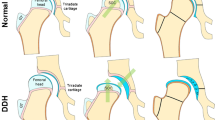Abstract
Objectives
The use of 3T magnetic resonance imaging (MRI) of the clavicle in forensic bone age determination was prospectively examined and compared with plain radiography.
Methods
Four MRI sequences and three radiographs of 121 healthy subjects between 11 and 30 were studied by two observers.
Results
The number of images assessable for bone age determination was lower for plain radiography (PA: 68.7%; oblique: 97.5%) compared with MRI (VIBE: 99.0%). Concerning the subjective level of difficulty to assess bone age, the observers found it easier to assess bone age on MRI than on radiography. The developmental stages of the clavicle, as used on plain radiography, were transferable to MRI. Especially the VIBE gradient echo sequence provided an excellent depiction of the growth cartilage and ossification centre with a slice thickness of 0.9 mm and only a 4-min acquisition time. When the developmental stages were assigned, less variability between the observers was seen on MRI, compared with plain radiography.
Conclusion
We conclude that 3T MRI provides high resolution, cross-sectional images of the maturation of the clavicle without ionising radiation in a very short time, allowing more accurate determination of bone age than plain radiography.













Similar content being viewed by others
References
Schmeling A, Geserick G, Reisinger W, Olze A (2007) Age estimation. Forensic Sci Int 165:178–181. doi:10.1016/j.forsciint.2006.05.016
Schmeling A, Kaatsch HJ, Marre B et al (2001) Empfehlungen für die Alterdiagnostik bei Lebenden im Strafverfahren. Rechtsmedizin 11:1–3
Schmeling A, Reisinger W, Geserick G, Olze A (2006) Age estimation of unaccompanied minors—Part I: general considerations. Forensic Sci Int 159:S61–S64
Schulz R, Mühler M, Reisinger W, Schmidt S, Schmeling A (2008) Radiographic staging of ossification of the medial clavicular epiphysis. Int J Leg Med 122:55–58. doi:10.1007/s00414-007-0210-6
Lockemann U, Fuhrmann A, Puschel K, Schmeling A, Geserick G (2004) Empfehlungen für die Alterdiagnostik bei Jugendlichen und jungen Erwachsenen ausserhalb des Strafverfahrens. Rechtsmedizin 14:123–125
Schmidt S, Muhler M, Schmeling A, Reisinger W, Schulz R (2007) Magnetic resonance imaging of the clavicular ossification. Int J Leg Med 121:321–324. doi:10.1007/s00414-007-0160-z
Dutch Ministry of Justice, Netherlands Forensic Institute (2008) Age Investigation Protocol. Dutch Ministry of Justice and the Netherlands Forensic Institute, The Netherlands. Available via http://www.forensischinstituut.nl. Accessed 3 June 2010
Schmeling A, Schulz R, Reisinger W, Muhler M, Wernecke KD, Geserick G (2004) Studies on the time frame for ossification of the medial clavicular epiphyseal cartilage in conventional radiography. Int J Leg Med 118:5–8. doi:10.1007/s00414-003-0404-5
Ludescher B, Martirosian P, Lenk S, Machann J, Dammann F, Schick F, Claussen C, Schlemmer H (2005) High-resolution magnetic resonance imaging of trabecular bone in the wrist at 3T: initial results. Acta Radiol 46:306–305. doi:10.1080/02841850510021076
Soher B, Dale B, Merkle E (2007) A review of MR physics: 3T versus 1.5T. Magn Reson imaging Clin N Am 15:277–290. doi:10.1016/j.mric.2007.06.002
Bauer J, Krause S, Ross C, Krug R, Carballido-Gamio J, Ozhinsky E, Majumdar S, Link T (2006) Volumetric cartilage measurements of porcine knee at 1.5-T and 3.0-T MR imaging: evaluation of precision and accuracy. Radiology 241:399–406
Blamire A (2008) The technology of MRI-the next 10 years. Br J Radiol 81:601–617. doi:10.1259/bjr/96872829
Kreitner KF, Schweden FJ, Riepert T, Nafe B, Thelen M (1998) Bone age determination based on the study of the medial extremity of the clavicle. Eur Radiol 8:1116–1122
Flecker H (1942) Time of appearance and fusion of ossification centers as observed by roentgenographic methods. AJR Am J Roentgenol 47:97–159
Destouet JM, Gilula LA, Murphy WA, Sagel SS (1981) Computed-tomography of the sternoclavicular joint and sternum. Radiology 138:123–128
Lucet L, LeLoet X, Menard JF et al (1996) Computed tomography of the normal sternoclavicular joint. Skeletal Radiol 25:237–241
Robben S (2004) Uitspraak rechtbank ’s Gravenhage inzake leeftijdsonderzoek. Memorad 9:14–15
Ramsthaler F, Proschek P, Betz W, Verhoff MA (2009) How reliable are the risk estimates for X-ray examinations in forensic age estimations? A safety update. Int J Leg Med 123:199–204. doi:10.1007/s00414-009-0322-2
Richardson DB, Wing S, Hoffmann W (2001) Cancer risk from low-level ionizing radiation: the role of age at exposure. State Art Rev Occup Med 16:191–218
Brenner DJ, Elliston CD, Hall EJ, Berdon WE (2001) Estimated risks of radiation-induced fatal cancer from pediatric CT. AJR Am J Roentgenol 176:289–296
Jung H (2000) Strahlenrisiken durch Röntgenuntersuchungen zur Alterschätzung im strafverfahren. Fortschr Röntgenstr 172:553–556
Schmeling A, Reisinger W, Wormanns D, Geserick G (2000) Strahlenexposition bei Röntgenuntersuchungen zur forensischen Alterschätzung Lebender. Rechtsmedizin 10:135–137
Okkalides D, Fotakis M (1994) Patient effective dose resulting from radiographic examinations. Br J Radiol 67:564–572
Jurik AG, Jensen LC, Hansen J (1996) Radiation dose by spiral CT and conventional tomography of the sternoclavicular joints and the manubrium sterni. Skeletal Radiol 25:467–470
Schulz R, Zwiesigk P, Schiborr M, Schmidt S, Schmeling A (2008) Ultrasound studies on the time course of clavicular ossification. Int J Leg Med 122:163–167. doi:10.1007/s00414-007-0220-4
Quirmbach F, Ramsthaler F, Verhoff MA (2009) Evaluation of the ossification of the medial clavicular epiphysis with a digital ultrasonic system to determine the age threshold of 21 years. Int J Leg Med 123:241–245. doi:10.1007/s00414-009-0335-x
Author information
Authors and Affiliations
Corresponding author
Rights and permissions
About this article
Cite this article
Hillewig, E., De Tobel, J., Cuche, O. et al. Magnetic resonance imaging of the medial extremity of the clavicle in forensic bone age determination: a new four-minute approach. Eur Radiol 21, 757–767 (2011). https://doi.org/10.1007/s00330-010-1978-1
Received:
Revised:
Accepted:
Published:
Issue Date:
DOI: https://doi.org/10.1007/s00330-010-1978-1




